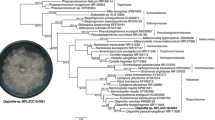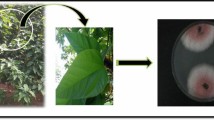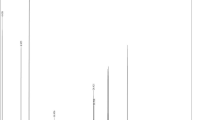Abstract
A total of fifty-four endophytic fungi were isolated from living symptomless leaves, stem and petals ofRosa damascaena Mill. (Rose). Rose is commercially exploited for the essential oil which is used in flavour and fragrances. Methyl eugenol [1,2-dimethoxy 4-(2-propenyl) benzene] constitutes about 1.9% composition of the rose oil and also acts as a precursor for the synthesis of methyl DOPA an important vasodilator. Besides this, it is an important bioactive compound with wide range of applications in pharmaceutical and flavouring industries. So far, methyl eugenol has been extracted either from rose oil or synthesized. During the present investigation GC-MS revealed the production of methyl eugenol by anAlternaria species isolated as an endophyte of cultivated and wild rose. The present work indicates that endophytes not only duplicate the secondary metabolite composition of host plant but can also serve as important tool for the preservation of biodiversity.
Similar content being viewed by others
References
Bills G., Dombrowski A., Pelaiz A., Polishook J. (2002). Recent and future discoveries of pharmacologically active metabolites from tropical fungi. In: Walting R., Franklin J.C., Tropical Mycology: Mictomycetes, CABI Publishing, New York, pp. 165–194.
Bryn H.D., Strobel G.A., Castilla U., Ezra D., Sears J., Weaver D.K., Runyan B.J. (2002). Napthelene an insect repellent produced byMuscoder vitigenus, a novel endophytic fungus. Microbiology, 148: 3737–3741.
Bouwmeester H.J. (2006). Engineering the essence of plants. Nat. Biotech., 24: 1361.
Dryfuss M.M., Chapela I.M. (1994). Potential of fungi in the discovery of novel low molecular weight pharmaceutical. Butterworth Heinemann, London, United Kingdom, pp. 49–80.
Gentile A., Rossi M.S., Cabral C., Craven K.D., Schardl C.L. (2005). Origin, divergence and phylogeny of epiochloe endophytes of native argentine grass. Mol. Phy. Evol., 35: 196–208.
Hu M.Y., Zhong G.H., Sun Z.T., Sh G., Liu H.M., Liu X.Q. (2005). Insecticidal activities of secondary metabolites of endophyticPenicillium inDerris elliptica Benth. J. Appl. Entomol., 129: 413–417.
Raviraja N.S. (2005). Fungal endophytes in five medicinal plant species from Kudremukh range, Western Ghats of India. J. Basic Microbiol., 3: 230–235.
Santos R.M.G., Rodrigues-Fo E., Rocha W.C., Teixeira M.F.S. (2003). Endophytic fungi fromMelia azadirchta. World J. Microbiol. Biotech., 19: 767–770.
Shelly T., Resilva S., Reyes M., Bignayan H. (1996). Feeding on methyl eugenol andFagraea berteriana flowers increases long-range female attraction by males of the oriental fruit fly (diptera: Tephritidae) Flor. Entomol., 79: 481–488.
Sieber T.N., Canavesk F., Darworth C.E. (1991). Endophytic fungi of red alder (Alnus rubera) leaves and twigs in British Columbia. Can. J. Bot., 69: 407–411.
Siegel M.R., Latch G.C., Johnson M.C. (1985).Acremonium fungal endophytes of Tall fescue and perennial Ryegrass. Plant Dis., 69: 179–183.
Stierle A., Strobel G., Stierle D. (1993). Taxol and taxane production byTaxomyces andreanae, an endophytic fungus of pacific yew. Science 260: 214–216.
Stone R. (1993). Surprise. A Fungal factory of Taxol? Science, 260: 154–155.
Stone R. (2001). Volatile metabolites of endophytes. Microbiology, 139: 134–140.
Strobel G.A., Dirksie E., Sears J., Marksworth C. (2001). Volatile antimicrobials fromMuscodor albus a novel endophytic fungus. Microbiology, 147: 2943–2950.
Tan R.X., Zou W.X. (2001). Endophyte a rich source of functional metabolites. Nat. Prod. Rep., 18: 448–459.
Vega E., Posada F., Peterson S.W., Gianfagna T.J., Chaves F. (2006).Penicillium species endophytic in coffee plants and ochratoxin A production. Mycologia, 98: 31–42.
Wani M. (2005). Molecular and metabolite profiling of fungal endophytes of Rose. M. Phil Dissertation, University of Jammu, Jammu, J & K, India
Zhang H.W., Song Y.C., Tan R.X. (2006). Biology and chemistry of endophytes. Nat. Prod. Rep., 23: 753–771.
Author information
Authors and Affiliations
Corresponding author
Rights and permissions
About this article
Cite this article
Kaul, S., Wani, M., Dhar, K.L. et al. Production and GC-MS trace analysis of methyl eugenol from endophytic isolate ofAlternaria from rose. Ann. Microbiol. 58, 443–445 (2008). https://doi.org/10.1007/BF03175541
Received:
Accepted:
Issue Date:
DOI: https://doi.org/10.1007/BF03175541




